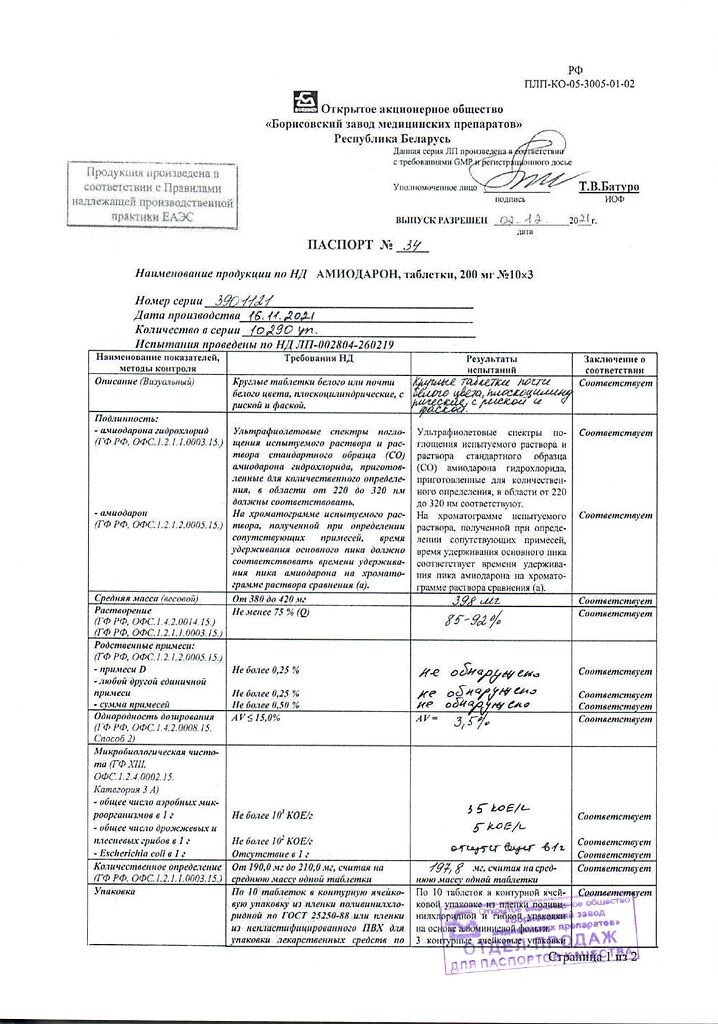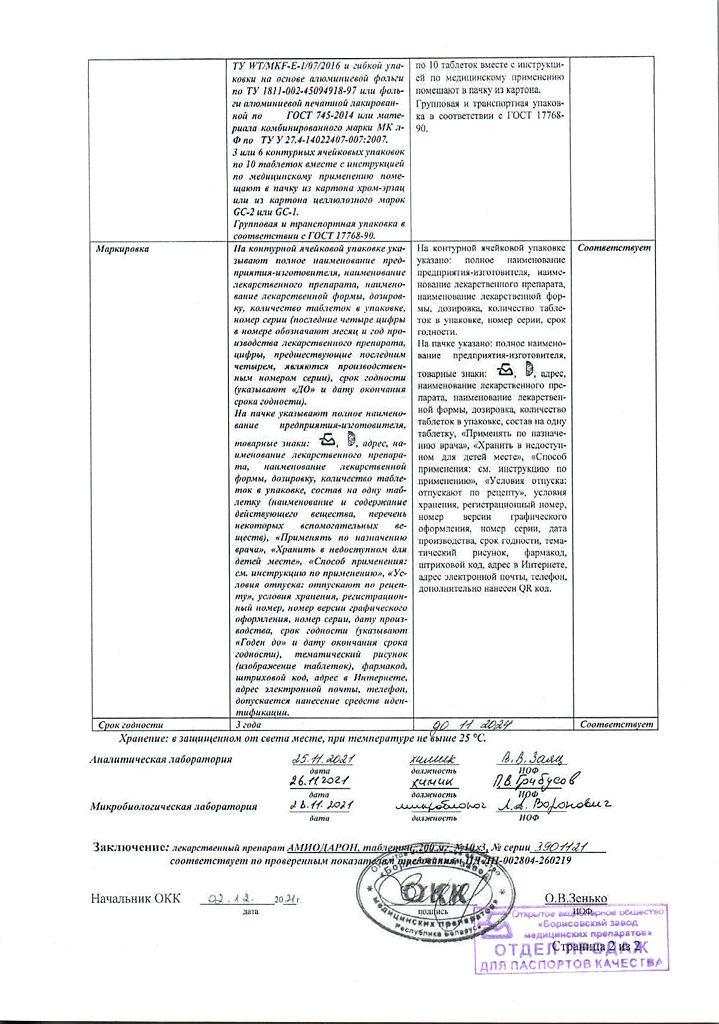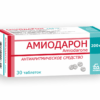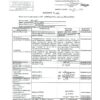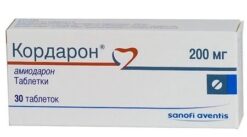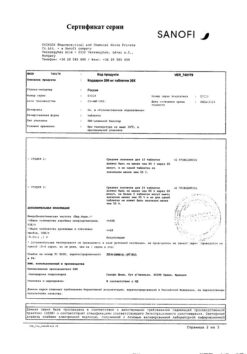No products in the cart.
Amiodarone, tablets 200 mg 30 pcs
€4.81 €4.28
Description
Class III antiarrhythmic drug (repolarization inhibitor). It also has antianginal, coronary dilation, alpha- and beta-adreno-blocking and antihypertensive effects.
Indications
Indications
Relapse Prevention
Pharmacological effect
Pharmacological effect
Class III antiarrhythmic drug (repolarization inhibitor). It also has antianginal, coronary dilation, alpha and beta adrenergic blocking and antihypertensive effects.
Special instructions
Special instructions
Caution should be exercised when prescribing the drug to patients with heart failure, liver disease, hypokalemia, porphyria, and elderly patients.
Active ingredient
Active ingredient
Amiodarone
Composition
Composition
1 tablet contains:
Contraindications
Contraindications
• Hypersensitivity to iodine, amiodarone or excipients of the drug.
• Lactose intolerance (lactase deficiency), glucose-galactose malabsorption syndrome (the drug contains lactose).
• Sick sinus syndrome (sinus bradycardia, sinoatrial block), except in cases of their correction with an artificial pacemaker (danger of “stopping” the sinus node).
• Atrioventricular block II-III degree, in the absence of an artificial pacemaker (pacemaker).
• Hypokalemia, hypomagnesemia.
• Combination with drugs that can prolong the QT interval and cause the development of paroxysmal tachycardias, including ventricular torsade de pointes (see section “Interaction with other drugs”):
– antiarrhythmic drugs: class IA (quinidine, hydroquinidine, disopyramide, procainamide); class III antiarrhythmic drugs (dofetilide, ibutilide, bretylium tosylate); sotalol;
– other (non-antiarrhythmic) drugs such as bepridil; vincamine; some neuroleptics: phenothiazines (chlorpromazine, cyamemazine, levomepromazine, thioridazine, trifluoperazine, fluphenazine), benzamides (amisulpride, sultopride, sulpride, tiapride, veralipride), butyrophenones (droperidol, haloperidol), sertindole, pimozide; cisapride; tricyclic antidepressants; macrolide antibiotics (in particular erythromycin when administered intravenously, spiramycin); azoles; antimalarial drugs (quinine, chloroquine, mefloquine, halofantrine); pentamidine for parenteral administration; difemanil methyl sulfate; mizolastine; astemizole, terfenadine; fluoroquinolones.
• Congenital or acquired prolongation of the QT interval.
• Thyroid dysfunction (hypothyroidism, hyperthyroidism).
• Interstitial lung disease.
• Pregnancy (see “Use during pregnancy and lactation”).
• Lactation period (see “Use during pregnancy and lactation”).
• Age under 18 years (efficacy and safety have not been established).
Side Effects
Side Effects
Frequency: very common (10% or more), common (1% or more; less than 10%), uncommon (0.1% or more; less than 1%), rare (0.01% or more; less than 0.1%), very rare (less than 0.01%, including isolated cases), frequency unknown (it is not possible to determine the frequency based on available data).
Interaction
Interaction
Contraindicated combinations: risk of developing polymorphic ventricular tachycardia of the “pirouette” type (arrhythmia characterized by polymorphic complexes that change the amplitude and direction of excitation in the ventricles relative to the isoline (electrical systole of the heart): class IA antiarrhythmic drugs (quinidine, hydroquinidine, disopyramide, procainamide), class III (dofetilide, ibutilide, bretylium tosylate), sotalol; bepridil, vincamine, phenothiazines (chlorpromazine, cyamemazine, levomepromazine, thioridazine, trifluoperasia, fluphenasia), benzamides (amisulpride, sultopride, sulpiride, tiapride, veraliprid), butyrophenones (droperidol, haloperidol), sertindole, pimozide; tricyclic antidepressants, cisapride, macrolides (erythromycin IV, spiramycin), azoles, antimalarial drugs (quinine, chloroquine, mefloquine, halofantrine, lumefantrine (parenteral), difemanil methyl sulfate, mizolastine, astemizole, terfenadine, fluoroquinolones (in); including moxifloxacin).
Not recommended combinations: beta-blockers, blockers of “slow” calcium channels (verapamil, diltiazem) – risk of impaired automaticity (severe bradycardia) and conduction; laxatives that stimulate intestinal motility – the risk of developing ventricular tachycardia of the “pirouette” type against the background of hypokalemia caused by laxatives.
Combinations that require use with caution: diuretics that cause hypokalemia, amphotericin B (intravenously), systemic glucocorticosteroids, tetracosactide – the risk of developing ventricular arrhythmias, incl. ventricular tachycardia of the “pirouette” type; procainamide – risk of developing side effects of procainamide (amiodarone increases the plasma concentration of procainamide and its metabolite -N-acetylprocainamide).
Overdose
Overdose
Symptoms: bradycardia, AV block, ventricular tachycardia of the “pirouette” type, paroxysmal tachycardia of the “pirouette” type, worsening of symptoms of existing CHF, impaired liver function, cardiac arrest.
Storage conditions
Storage conditions
In a place protected from light at a temperature not exceeding 25 ° C.
Keep out of the reach of children.
Shelf life
Shelf life
2 years.
Manufacturer
Manufacturer
Borisov Medical Preparations Plant, Belarus
Additional information
| Shelf life | 2 years. |
|---|---|
| Conditions of storage | In the dark place at the temperature not more than 25 °С. Keep out of reach of children. |
| Manufacturer | Borisov Medical Preparations Plant, Belarus |
| Medication form | pills |
| Brand | Borisov Medical Preparations Plant |
Other forms…
Related products
Buy Amiodarone, tablets 200 mg 30 pcs with delivery to USA, UK, Europe and over 120 other countries.


